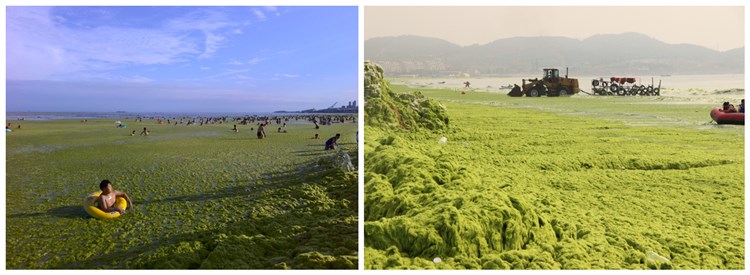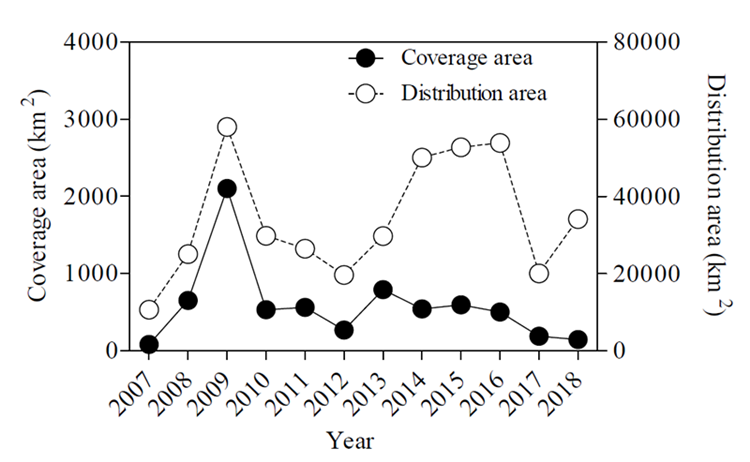Study Reveals Mechanisms that Turned the Yellow Sea Green
Chinese scientists have unraveled the complex suite of factors that contributed to the world’s largest green tide outbreak to date, in the Yellow Sea.
Their study was published in the peer-reviewed journal National Science Review, a joint publication of Oxford University Press and the Chinese Academy of Sciences. The team also proposed sustainable countermeasures that could help curb future outbreaks, providing both environmental and socio-economic benefits.
A green tide is caused by the excessive proliferation of a marine green plankton, which often brings many negative impacts on coastal ecosystem and social economy. Since the 1980s, green tide outbreaks have been affecting many countries, such as Japan, Philippines, Denmark, the Netherlands, Italy, France and the United States. Green tide outbreaks have serious environmental implications: decaying seaweed can degrade water quality and result in oxygen depletion and acidification. Oxygen stress can cause mass die-offs of marine life, including mariculture species such as abalone and sea cucumbers, leading to economic losses. Green tides can also have long-lasting ecological effects, such as impacting the refractory carbon pool and biogeochemical cycles in the offshore ecosystem.
Ulva prolifera, a species of large green seaweed, is found throughout the world's oceans, including the Yellow Sea, one of the world's largest areas of continental shelf covered in shallow water. The biological characteristics of Ulva prolifera give it a distinct competitive advantage over other species, enabling it to thrive and dominate in the Yellow Sea. It is fast-growing, utilizes various modes of reproduction to multiply, and is highly resistant to environmental changes, allowing it to quickly outcompete other species for nutrients, light, and space. Consequently, more than 90% of green-tide macroalgae is comprised of Ulva prolifera.

Fig.1: Green tides in the Yellow Sea in 2016. (Image by ZHANG Yongyu)
Over the last 13 years, Ulva prolifera has thrived in the Yellow Sea, covering an area exceeding 20,000 km2 (more than three times the size of Shanghai) during peak bloom periods. These green tides have significant environmental and socio-economic impacts, negatively affecting marine and coastal ecosystems as well as mariculture and tourism, resulting in direct economic losses estimated to be as high as $1.3 billion RMB (about $185 million U. S. dollars). Yet, the mechanisms that have fueled these outbreaks have not been fully understood, until now.

Fig.2: Coverage and distribution areas of the Yellow Sea Green Tides throughout the last decade. (Image by ZHANG Yongyu)
“The outbreak mechanisms of the Ulva prolifera green tide is much more complicated than we initially thought,” said ZHANG Yongyu, a scientist at the Qingdao Institute of Bioenergy and Bioprocess Technology (QIBEBT), Chinese Academy of Sciences and lead author of the paper.
The study shows that green tide outbreaks in the Yellow Sea cannot be attributed to a single factor, but rather are caused by a perfect storm of contributing factors. These include human activities (nutrient inputs, mariculture), environmental conditions (including ocean warming), biological and physiological characteristics of Ulva prolifera, and its interactions with microorganisms and other macroalgae species.
The authors suggest that the dynamic interplay between these various factors could have contributed to the sudden appearance of green tides in 2007 and their abrupt decline, yet wider distribution, in 2017. For example, after the green tide outbreak, the coastal environment will be degraded in the short term, while in the long term, it may affect biogeochemical cycles and levels of dissolved organic carbon in coastal waters that is not readily available for organisms to utilize, ZHANG explains.
The authors propose several management strategies to control green tide outbreaks in the Yellow Sea, including turning this problem species into a viable resource. Some of the measures they propose include:
The proposed strategies could also potentially provide management solutions to control green tide outbreaks in other parts of the world.
Contact:
CHENG Jing
Qingdao Institute of Bioenergy and Bioprocess Technology, Chinese Academy of Sciences
Tel: 86-532-80662647
E-mail: chengjing@qibebt.ac.cn